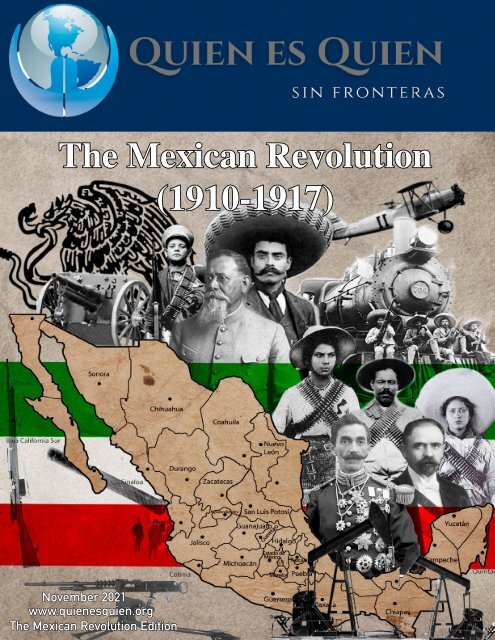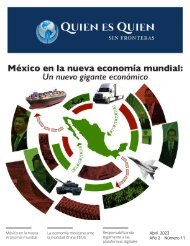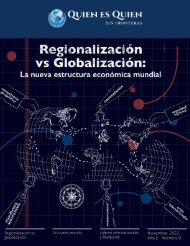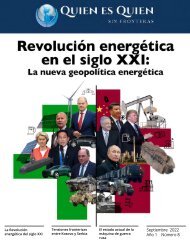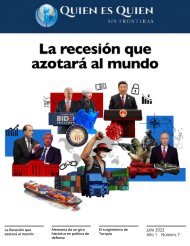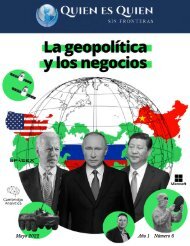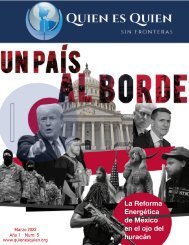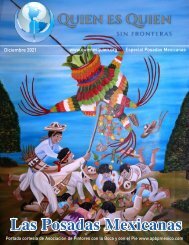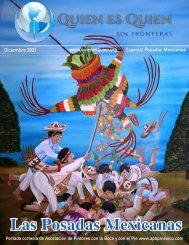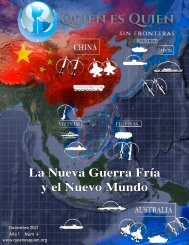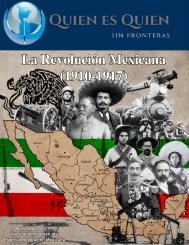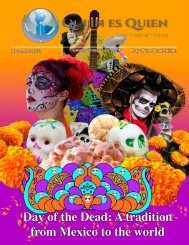Mexican Revolution Edition 2021 I Quién es Quién Sin Fronteras
Free digital magazine, Mexican Revolution Edition 2021 I Quién es Quién Sin Fronteras, which publishes articles about culture, tourism, economy, development and more
Free digital magazine, Mexican Revolution Edition 2021 I Quién es Quién Sin Fronteras, which publishes articles about culture, tourism, economy, development and more
Create successful ePaper yourself
Turn your PDF publications into a flip-book with our unique Google optimized e-Paper software.
The <strong>Mexican</strong> <strong>Revolution</strong><br />
(1910-1917)<br />
November <strong>2021</strong><br />
www.quien<strong>es</strong>quien.org<br />
The <strong>Mexican</strong> <strong>Revolution</strong> <strong>Edition</strong>
The <strong>Mexican</strong> <strong>Revolution</strong><br />
(1910 - 1917 )<br />
accumulated wealth<br />
in the power of only a<br />
few, and the extreme<br />
poverty of the majority<br />
of the people.<br />
The subhuman conditions<br />
of the farmers,<br />
who, in addition to<br />
lacking land for cultivation,<br />
suffered the<br />
mistreatment of the<br />
foremen, prevailing<br />
at all tim<strong>es</strong> the conditions<br />
of servitude.<br />
Who´s Who<br />
General Director<br />
Carlos Castillo<br />
Director Administrativo<br />
Juan Coronel<br />
Editorial Director<br />
Alejandro Araujo<br />
Marketing Director<br />
Trinidad Ravelo<br />
Redaction<br />
M. Rodríguez<br />
Citlalli Puente<br />
“<strong>Quién</strong> <strong>es</strong> <strong>Quién</strong><br />
<strong>Sin</strong> <strong>Fronteras</strong>”<br />
T<br />
he <strong>Mexican</strong> <strong>Revolution</strong><br />
was an<br />
armed movement<br />
initiated in 1910 to<br />
end the dictatorship of<br />
General Porfirio Diaz.<br />
It officially culminated<br />
with the promulgation<br />
of the new Political<br />
Constitution of the<br />
United <strong>Mexican</strong> Stat<strong>es</strong><br />
of 1917, the first in<br />
the world to recognize<br />
social guarante<strong>es</strong> and<br />
collective labor rights.<br />
At the beginning of<br />
Porfirio Diaz’s mandate,<br />
there were<br />
uprisings of people<br />
belonging to the old<br />
liberal regime. This,<br />
combined with a seri<strong>es</strong><br />
of political, economic,<br />
and social<br />
events, was the critical<br />
point for the emergence<br />
of the <strong>Mexican</strong><br />
<strong>Revolution</strong> movement.<br />
Its origin can be defined<br />
as the r<strong>es</strong>ult of<br />
the following caus<strong>es</strong>.<br />
Political Caus<strong>es</strong>:<br />
An aging regime in<br />
the absence of integration<br />
or formation<br />
of new leaders and<br />
the natural drive of<br />
the new generations.<br />
Social Caus<strong>es</strong>:<br />
The poor administration<br />
of justice, the<br />
Likewise, the working<br />
conditions of the<br />
factory workers, with<br />
long working hours<br />
ranging from 14 to<br />
16 hours a day in exchange<br />
for a miserable<br />
and unfair salary.<br />
The adoption of<br />
French culture over<br />
nationalist culture,<br />
but above all, the inability<br />
shown by General<br />
Porfirio Diaz to understand<br />
the needs of<br />
social justice and political<br />
participation.<br />
The <strong>Mexican</strong> <strong>Revolution</strong><br />
<strong>Edition</strong> 1910-1917<br />
Pictur<strong>es</strong> and information<br />
from “Las Fuerzas Armadas<br />
en la Revolción <strong>Mexican</strong>a”<br />
e-mail<br />
info@quien<strong>es</strong>quien.org<br />
Web Page<br />
www.quien<strong>es</strong>quien.org<br />
Frontier Magazin<strong>es</strong><br />
Productions<br />
2000 Sur McColl<br />
Suite B-128<br />
McAllen, Tx.<br />
CP 78503<br />
tel. (956) 309 - 3846<br />
<strong>Quién</strong> <strong>es</strong> quién sin fronteras<br />
All Rights R<strong>es</strong>erved<br />
The <strong>Mexican</strong> <strong>Revolution</strong> <strong>Edition</strong>, November <strong>2021</strong><br />
<strong>Quién</strong> <strong>es</strong> quién sin fronteras
CONTENTS<br />
Francisco Villa and<br />
the North Division......................................................................Page 5<br />
The North Division<br />
and the objectiv<strong>es</strong> of<br />
the <strong>Revolution</strong> ..............................................................Page 9<br />
The War Campaings:<br />
“Orozco, Huerta<br />
And Villa” ...........................................................Page 12<br />
Minors in the<br />
<strong>Mexican</strong> <strong>Revolution</strong>..........................................................Page 17<br />
The Women´s<br />
participations ..........................................................Page 23<br />
Tragic Decade ...................................................Page 26<br />
The US<br />
Intervention ..........................................................Page 27<br />
Consummation<br />
of the <strong>Revolution</strong> ..........................................................Page 29<br />
The <strong>Mexican</strong> <strong>Revolution</strong> <strong>Edition</strong>, November <strong>2021</strong>
Francisco Villa and<br />
the North Division<br />
F<br />
rancisco Villa, a character<br />
of great popularity in the<br />
history of Mexico. His real<br />
name was Doroteo Arango Arámbula,<br />
born in La Coyotada, near<br />
the Rio Grande ranch, Municipality<br />
of San Juan del Rio, State<br />
of Durango, on June 5, 1878. It<br />
is known that he did not attend<br />
school and was orphaned at an<br />
early age.<br />
In September 1894, according<br />
to his autobiography, he wounded<br />
Agustín López Negrete, a landowner<br />
who wanted to take advantage<br />
of his younger sister, so<br />
he had to flee from the hacienda<br />
and take refuge in the Silla and<br />
Gamón mountains.<br />
Having adopted the name of<br />
Francisco Villa, he dedicated to<br />
cattle rustling as his main activity,<br />
but he also worked as a miner,<br />
bricklayer, tanner, and butcher.<br />
Shortly after, he moved to the<br />
state of Chihuahua, where he met<br />
Abraham González, Pr<strong>es</strong>ident of<br />
the Anti-Reelectionist Club of the<br />
state, in 1909, who convinced him<br />
to join the armed movement and<br />
sent him to Sierra Azul, located<br />
south of the state, to organize an<br />
armed uprising against the government<br />
of General Porfirio Díaz.<br />
For a few weeks, he was in the<br />
Page 6<br />
rebel group of rebel Cástulo Herrera.<br />
Still, his personality and<br />
leadership qualiti<strong>es</strong> allowed him to<br />
be appointed leader of the region’s<br />
revolutionari<strong>es</strong>. He participated in<br />
the actions of Bajío del Tecolote,<br />
San Andrés, Camargo and Las Escobas,<br />
in which he was defeated.<br />
When he learned that Don Francisco<br />
I. Madero was in the state of<br />
Chihuahua, he immediately joined<br />
him in the town of Bustillos, in<br />
April 1911, where Madero granted<br />
him the rank of Colonel. From<br />
the first meeting, both characters<br />
formed a good friendship. Villa<br />
immediately subordinated himself<br />
to Madero, believing that Madero<br />
was fighting for the welfare of the<br />
people.<br />
On May 9, 1911, while the revolutionary<br />
troops were on the<br />
outskirts of Ciudad Juarez, Villa<br />
and Pascual Orozco noticed that<br />
keeping the plaza under siege was<br />
a waste of time, so they decided<br />
to take it, with blood and fire.<br />
Afterward, Villa and Orozco had<br />
disagreements with Madero because<br />
of General Juan S. Navarro,<br />
who defended said plaza. Villa and<br />
Orozco wanted to shoot him, but<br />
Madero set him free. So the leader<br />
from Durango left his troops and<br />
retired to civilian life after receiv-<br />
<strong>Quién</strong> <strong>es</strong> quién sin fronteras
Page 7<br />
ing compensation for the servic<strong>es</strong><br />
rendered to the revolution.<br />
The Northern Division<br />
In February 1912, when the rebellion<br />
led by Orozco took place,<br />
Villa left Chihuahua City, gathering<br />
approximately 500 men. He confronted<br />
the rebels in several actions<br />
and finally joined the Northern<br />
Division of the Federal Army,<br />
commanded by General Victoriano<br />
Huerta. A unit with which he actively<br />
participated in Tlahualilo,<br />
Conejos, Escalon, and Rellano, in<br />
which Pascual Orozco was defeated,<br />
for which the Secretary of War<br />
and Navy granted Villa the rank of<br />
Honorary Brigadier General.<br />
When taking a town, Villa first<br />
informed himself of the situation.<br />
Then he demanded food and money<br />
from the authoriti<strong>es</strong> and merchants<br />
to pay his troops, leaving<br />
them vouchers so that when the<br />
cause triumphed, they would be<br />
paid. Finally, he would order to<br />
open the merchant’s stor<strong>es</strong> so that<br />
the people could take what they<br />
needed. This is why they were<br />
seen as liberators and had followers<br />
loyal to the cause.<br />
On August 26, 1913, Francisco<br />
Villa, with a little more than 1,000<br />
men, took San Andr<strong>es</strong>, Chih., defended<br />
by the Orozquistas, commanded<br />
by Felix Terrazas; the<br />
Battle lasted several hours, and finally,<br />
the defenders had to vacate<br />
the square. The villistas seized<br />
seven trains, two cannons, 421 rifl<strong>es</strong>,<br />
and about 20,000 cartridg<strong>es</strong>.<br />
Against all expectations, Villa<br />
went to Camargo, Chihuahua,<br />
where he was joined by the revolutionari<strong>es</strong><br />
Maclovio Herrera with<br />
his Benito Juarez Brigade and Trinidad<br />
Rodriguez. They had accepted<br />
the “Centaur of the North” as<br />
Chief.<br />
Villa’s first action as Chief of the<br />
Northern Division was attacking<br />
Lerdo, Gómez Palacio, and Torreón,<br />
which were defended by<br />
about 5,000 men, commanded by<br />
General Eutiquio Munguía. Of the<br />
total federal troops, more than<br />
half were Orizquistas led by Benjamín<br />
Argumedo. Villa ordered<br />
the “Benito Juarez” and “Madero”<br />
brigad<strong>es</strong>, supported by a fraction<br />
of the “Juarez de Durango,”<br />
which had the “Volunteers of the<br />
Lagoon” as a r<strong>es</strong>erve, to advance<br />
along the north bank of the Nazas<br />
River.<br />
When Francisco Villa took command<br />
of the Northern Division,<br />
his main concern was to organize<br />
a great unit, the “undisciplined<br />
rabble,” into a well-organized<br />
body. Above all, he wanted to<br />
sow in his people that the cause<br />
for which they were fighting was<br />
the <strong>Revolution</strong>, that the fight was<br />
against all those who exploited<br />
the poor and humiliated, against<br />
those who persecuted and dishonored<br />
them. The objective of<br />
their struggle was to overthrow<br />
the dictatorship that was becoming<br />
unbearable due to the lack of<br />
justice and liberti<strong>es</strong>.<br />
The Northern Division was<br />
a great unit that came out of<br />
nowhere, that broke all the<br />
schem<strong>es</strong> of the armi<strong>es</strong> of the<br />
<strong>Revolution</strong> since it was joined by<br />
all kinds of people from diverse<br />
origins. From bandits, peasants,<br />
ranchers, miners to members of<br />
the middle class and prof<strong>es</strong>sional<br />
military.<br />
A great number of the members<br />
of the Northern Division joined<br />
this unit because Villa was an authentic<br />
leader who was followed<br />
unconditionally by a significant<br />
number of regional chiefs who<br />
obeyed his orders almost blindly<br />
because of his fight against the<br />
rich and his generosity with the<br />
poor.<br />
The <strong>Mexican</strong> <strong>Revolution</strong> <strong>Edition</strong>, November <strong>2021</strong><br />
<strong>Quién</strong> <strong>es</strong> quién sin fronteras
The Northern Division and<br />
the objectiv<strong>es</strong> of the revolution<br />
O<br />
n November 2, 1913, in<br />
Estación Consuelo, Chihuahua<br />
Villa asked General<br />
Mercado to surrender the<br />
plaza of Chihuahua or leave it<br />
to fight in the open field, which<br />
was rejected. The villistas took<br />
positions for the battle while the<br />
defenders prepared to defend<br />
themselv<strong>es</strong>, taking advantage of<br />
the terrain conditions.<br />
After the setback in Chihuahua,<br />
Villa decided to take Ciudad<br />
Juarez. For effect, the villistas<br />
captured a coal train and<br />
forced the telegraphists to send<br />
m<strong>es</strong>sag<strong>es</strong> to the station chief of<br />
Ciudad Juarez that they had returned<br />
to the border city.<br />
The next objective of the<br />
Northern Division was the Chihuahua<br />
Plaza, but they had to<br />
take it before reinforcements<br />
arrived from Torreon, while internal<br />
problems grew stronger.<br />
Knowing that the federal forc<strong>es</strong>,<br />
mainly orozquistas or colorados,<br />
were heading to Ciudad<br />
Juarez to confront the Northern<br />
Division, Villa decided to confront<br />
them in an open zone.<br />
The Tierra Blanca station, 31<br />
kilometers south of the old Paso<br />
del Norte. The Battle of Tierra<br />
Blanca began on November 24,<br />
obtaining a victory of great importance<br />
for the <strong>Revolution</strong>.<br />
Villa’s next objective was to<br />
take Ojinaga and wipe out the<br />
federal troops in the state of<br />
Chihuahua. Hundreds of soldiers<br />
crossed the Bravo River and<br />
took refuge in the United Stat<strong>es</strong>.<br />
Many others d<strong>es</strong>erted and<br />
joined Villa, who remained lost,<br />
without artillery, almost without<br />
a park, and were defeated before<br />
starting the battle, fighting<br />
only for pride.<br />
It is worth mentioning that<br />
while a part of the Northern Division<br />
made an effort to control<br />
the state of Chihuahua, another<br />
part stayed in Torreon and<br />
northern Durango, having several<br />
confrontations in Saltillo,<br />
General Cepeda, Parras and Vi<strong>es</strong>ca,<br />
Coah. In this situation, a<br />
new Brigade was integrated, the<br />
Carranza, with people from the<br />
Carranza Regiment of the First<br />
Brigade of Durango, which from<br />
its creation was considered part<br />
of the Northern Division.<br />
In March 1914, the Northern<br />
Division went to La Laguna<br />
to recover the towns of Torreón,<br />
Gómez Palacio, and Lerdo,<br />
which were defended by the<br />
Nazas Division of the Federal<br />
Army. After controlling the lagoon<br />
region, Villa had several<br />
Página Page 10<br />
problems with Venustiano Carranza.<br />
He tried to solve it in the<br />
b<strong>es</strong>t way and even marched to<br />
take the plaza of Saltillo, Coahuila,<br />
knowing that this was<br />
part of the territory that corr<strong>es</strong>ponded<br />
to the Northeastern<br />
Army Corps.<br />
Villa r<strong>es</strong>igned as commander<br />
of the Northern Division. Still,<br />
his brigade chiefs did not accept<br />
the r<strong>es</strong>ignation, and all of them<br />
unsubordinated against Carranza’s<br />
order saying that Villa was<br />
the only commander they recognized.<br />
Finally, “The Centaur of<br />
the North” continued to lead the<br />
Division and went to Zacatecas,<br />
not to support Nátera, but to<br />
take the town, to show Carranza<br />
the strength of his troops.<br />
The taking of Zacatecas was<br />
the bloodi<strong>es</strong>t of the battl<strong>es</strong> of<br />
the <strong>Revolution</strong> and the most<br />
significant and most brilliant<br />
action of the Northern Division,<br />
in which the artillery directed by<br />
General Felipe Ángel<strong>es</strong> stands<br />
out; this battle was planned<br />
with the basic principl<strong>es</strong> of military<br />
art.The city of Zacatecas<br />
had strategic importance for<br />
both the Constitutionalist Army<br />
and the Federal Army since it<br />
was a railroad crossing, which<br />
The <strong>Mexican</strong> <strong>Revolution</strong> <strong>Edition</strong>, November <strong>2021</strong><br />
<strong>Quién</strong> <strong>es</strong> quién sin fronteras
Page 11<br />
was the obligatory passage from<br />
the North of the country to Mexico<br />
City. This victory is considered<br />
a masterpiece of military<br />
science. The villistas captured<br />
6,000 prisoners, 12 cannons,<br />
300 machine guns, and 12 rifl<strong>es</strong>.<br />
With this victory, the Constitutionalists<br />
had a free road to<br />
Mexico City, and it was the decisive<br />
blow for the fall of General<br />
Victoriano Huerta’s government.<br />
However, in the Bajío, the<br />
r<strong>es</strong>ults in combat were not as<br />
expected, and the Northern Division<br />
ceased to exist in 1915;<br />
Villa, with a small group of his<br />
loyal troops, took refuge in the<br />
state of Chihuahua, returning to<br />
guerrilla life.<br />
One of the objectiv<strong>es</strong> of the<br />
thousands of men who made<br />
the <strong>Mexican</strong> <strong>Revolution</strong> possible<br />
was to change society, to make<br />
it fairer so future generations<br />
would have a more dignified life<br />
than they or their anc<strong>es</strong>tors.<br />
Francisco Villa was one of those<br />
thousands of <strong>Mexican</strong>s who<br />
joined the revolutionary maelstrom<br />
and, with his contribution,<br />
influenced chang<strong>es</strong> in all areas<br />
of <strong>Mexican</strong> society.We can assure<br />
that since Villa joined the<br />
revolution in November 1910,<br />
until his entrance to Mexico City<br />
in December 1915, he did not<br />
issue any document in favor of<br />
the farmers or workers. However,<br />
after he joined the Zapatistas,<br />
he was influenced by the<br />
farmers of the south. In May<br />
1915, he issued the General<br />
Agrarian Law to fulfill the revolutionary<br />
promis<strong>es</strong> and as a basis<br />
for the country’s pacification.<br />
Although General Villa was<br />
defeated in the battl<strong>es</strong> of Celaya<br />
and La Trinidad in April-May<br />
1915, and his agricultural project<br />
could not be carried out, its<br />
foundations were embodied in<br />
the Constitution of 1917. D<strong>es</strong>pite<br />
the Magna Carta being<br />
drafted by the constitutionalists,<br />
the victors of the Northern<br />
Division fulfilled part of the objectiv<strong>es</strong><br />
sought by all <strong>Mexican</strong>s<br />
who decided to fight in the <strong>Mexican</strong><br />
<strong>Revolution</strong>.<br />
The Magna Carta of 1917 was<br />
the pinnacle in which the regenerative<br />
movement reflected its<br />
ideals of equality and social justice<br />
that still govern the liv<strong>es</strong> of<br />
all <strong>Mexican</strong>s. Foundations that<br />
since its promulgation has been<br />
a guide to issue the rul<strong>es</strong> that<br />
currently govern the <strong>Mexican</strong><br />
state to achieve the welfare of<br />
the <strong>Mexican</strong> people.<br />
The <strong>Mexican</strong> <strong>Revolution</strong> <strong>Edition</strong>, November <strong>2021</strong><br />
T<br />
The War Campaigns:<br />
Huerta, Orozco and Villa<br />
he History of the Northw<strong>es</strong>t<br />
Army Corps is part of the<br />
golden pag<strong>es</strong> of the History<br />
of the <strong>Mexican</strong> Army and the History<br />
of Mexico. Its actions were of<br />
utmost relevance in the <strong>Mexican</strong><br />
<strong>Revolution</strong> of 1910: The defeats of<br />
General Pascual Orozco and General<br />
Francisco Villa.<br />
The background of the Northw<strong>es</strong>t<br />
Army begins at the beginning<br />
of 1912 when some groups that<br />
at first had supported the Plan of<br />
San Luis, proclaimed by Francisco<br />
I. Madero pronounced themselv<strong>es</strong><br />
against it. Specifically, it has its<br />
origin with Orozco’s ignorance<br />
against Madero’s regime.<br />
<strong>Quién</strong> <strong>es</strong> quién sin fronteras<br />
The campaign against<br />
General Orozco<br />
Pascual Orozco was a native of<br />
Chihuahua, rancher, muleteer, and<br />
merchant. He was the first leader<br />
of the armed movement and is<br />
credited with the victory over the<br />
federal troops guarding the plaza<br />
of Ciudad Juarez, with which General<br />
Porfirio Diaz r<strong>es</strong>igned from<br />
the pr<strong>es</strong>idency.<br />
However, due to misunderstandings<br />
between General Orozco and<br />
Madero, mainly because the latter<br />
did not attend to the demands of<br />
social justice and left the structure<br />
of the federal army intact, Orozco<br />
disowned him as pr<strong>es</strong>ident on<br />
March 3, 1912.
Page 13<br />
The first confrontations between<br />
Orozco’s supporters and federal<br />
forc<strong>es</strong>, commanded by General<br />
José González Salas, took place in<br />
Chihuahua, on March 23, 1912, in<br />
Rellano. The former achieved victory<br />
and two days later expr<strong>es</strong>sed<br />
their demands in a manif<strong>es</strong>to<br />
known as the “Plan de la Empacadora.”<br />
At the end of May, a second confrontation<br />
took place in the Rellano<br />
square. This time the federal<br />
army, commanded by General Victoriano<br />
Huerta, managed to defeat<br />
the insurgents and little by little<br />
managed to decimate their forc<strong>es</strong><br />
until gaining control of Chihuahua<br />
and Ciudad Juarez on August 16<br />
of that year. After being wounded<br />
in a confrontation in the city of<br />
Ojinaga, Orozco took refuge in the<br />
neighboring country to the north,<br />
where he rethought his strategy.<br />
Upon his return in December1912,<br />
Orozco’s priority was<br />
to gain supporters. He began an<br />
arduous campaign to recruit rural<br />
workers, and former Maderista<br />
combatants discharged after the<br />
revolutionary triumph, members<br />
of the federal army, and anyone<br />
who decided to support him.<br />
On September 19, at Rancho de<br />
San Joaquín, the Maderista forc<strong>es</strong><br />
prevailed again against the<br />
Oozquistas d<strong>es</strong>pite their numerical<br />
inferiority. Obregón was promoted<br />
to the rank of colonel for demonstrating<br />
his skills in the science of<br />
war. The victori<strong>es</strong> of the Maderista<br />
groups helped immensely in the<br />
defeat of Pascual Orozco.<br />
The campaign against<br />
Victoriano Huerta<br />
In 1913, Venustiano Carranza<br />
had disowned the government of<br />
General Victoriano Huerta and had<br />
initiated the organization of the<br />
Constitutionalist Army, of which he<br />
was the First Chief and whose purpose<br />
was to defend the principl<strong>es</strong><br />
of the Magna Carta.<br />
A decree was issued in the city<br />
of Monclova, Coahuila, which stipulated<br />
the organization of the<br />
Constitutionalist Army in seven<br />
Army Corps: corr<strong>es</strong>ponding to<br />
the Northw<strong>es</strong>t, Northeast, East,<br />
W<strong>es</strong>t, Center, South, and Southeast.<br />
However, only three fractions<br />
of this army went into effect, the<br />
Army Corps of the Northw<strong>es</strong>t and<br />
Northeast and the Northern Division,<br />
under the command of Francisco<br />
Villa.<br />
Throughout 1914, the Northw<strong>es</strong>t<br />
Army fought three <strong>es</strong>sential<br />
battl<strong>es</strong> in its march towards the<br />
south. Of which, the following<br />
stand out; the capture of Tepic,<br />
Nayarit, the Battle of La Venta-Orendain,<br />
and the capture of<br />
Colima.<br />
With th<strong>es</strong>e victori<strong>es</strong>, the revolutionary<br />
army managed to control<br />
the northw<strong>es</strong>t and w<strong>es</strong>t of the<br />
country. This let General Obregón<br />
advance towards Mexico City, and<br />
thanks to the victory of the Northern<br />
Division in Zacatecas, the passage<br />
was unstoppable.<br />
Thus, on July 15, 1914, Victoriano<br />
Huerta left the country’s pr<strong>es</strong>idency<br />
in the hands of Carvajal<br />
to hand it over to the triumphant<br />
<strong>Revolution</strong>, with the signing of the<br />
Treati<strong>es</strong> of Teoloyucan, on August<br />
13, 1914.<br />
Alvaro Obregón’s troops entered<br />
the country’s capital on August<br />
15 and, on the 20th of the same<br />
month, Venustiano Carranza entered<br />
Mexico City, thus becoming<br />
Provisional Pr<strong>es</strong>ident of Mexico.<br />
The <strong>Mexican</strong> <strong>Revolution</strong> <strong>Edition</strong>, November <strong>2021</strong><br />
<strong>Quién</strong> <strong>es</strong> quién sin fronteras
Page 15<br />
Page 16<br />
The campaign against<br />
General Francisco Villa<br />
After disarming the Constitutionalist<br />
troops, Carranza appointed<br />
his cabinet. However, a<br />
long-standing rivalry, added to recent<br />
events, provoked the rupture<br />
between the First Chief and the<br />
General in Chief of the Northern<br />
Division, Francisco Villa, who until<br />
then had fought on the Constitutionalist<br />
side.<br />
Because of the disagreements<br />
between the Carrancistas and Villistas<br />
and the still revolted Zapatistas,<br />
a Convention was called to<br />
meet first in Mexico City, on October<br />
1st, and later in Aguascalient<strong>es</strong>,<br />
to r<strong>es</strong>olve the situation.<br />
Due to the irreconcilable positions<br />
of both Carranza and General<br />
Villa, the Aguascalient<strong>es</strong> Convention<br />
agreed to remove both from<br />
their posts and appoint General<br />
Eulalio Gutiérrez as Provisional<br />
Pr<strong>es</strong>ident who in turn was forced<br />
to appoint General Villa as Chief of<br />
the Conventionist Army.<br />
Faced with this ruse, Carranza<br />
refused to accept the decision<br />
of the Convention, giving rise to<br />
what some authors call the third<br />
stage of the <strong>Revolution</strong> or the<br />
“Factional Struggle” between Carranza<br />
and Villa, joined by the Liberation<br />
Army of the South, led by<br />
Emiliano Zapata.<br />
On December 3, 1914, General<br />
Villa entered Mexico City at the<br />
head of the conventionist troops.<br />
Evidently, Carranza did not accept<br />
this imposition, and the country<br />
was trapped in the middle of two<br />
governments and again plunged<br />
into war. On the 14th, both sid<strong>es</strong><br />
fought fiercely. However, Villa’s<br />
troops began to retreat, and his<br />
strategy was maintained with few<br />
variations. On the 15th, given the<br />
succ<strong>es</strong>sful advance, the Army of<br />
Operations changed from a defensive<br />
tactic to an offensive one, and<br />
it was a double cavalry envelopment<br />
that consummated the victory.<br />
Due to the decimation of his<br />
troops, General Francisco Villa understood<br />
that he could not continue<br />
fighting as a formal army and<br />
decided to disintegrate the Northern<br />
Division and keep on fighting<br />
with a guerrilla-type strategy.<br />
In this way, in a short time, the<br />
Army of Operations managed to<br />
pacify the north of the country<br />
and continued with the task of dismembering<br />
the r<strong>es</strong>istance that still<br />
supported General Villa.<br />
The <strong>Mexican</strong> <strong>Revolution</strong> <strong>Edition</strong>, November <strong>2021</strong><br />
<strong>Quién</strong> <strong>es</strong> quién sin fronteras
Page 17<br />
Minors: Social Actors in<br />
the <strong>Mexican</strong> <strong>Revolution</strong><br />
T<br />
he <strong>Mexican</strong> <strong>Revolution</strong> was<br />
the first significant social<br />
movement of the 20th century.<br />
It meant a violent change<br />
in the country’s political, economic,<br />
and social institutions, in<br />
which men, women, and minors<br />
(boys and girls) took part.<br />
To create and organize an<br />
army that would re<strong>es</strong>tablish the<br />
constitutional order in the national<br />
territory, the most important<br />
thing required, “the soldier.”<br />
It was recruited from the civilian<br />
population affected, both by<br />
the revolutionary side and the<br />
federal government, since both<br />
contenders extracted the farmers<br />
from the villag<strong>es</strong> and turned<br />
them into soldiers.<br />
Sometim<strong>es</strong> th<strong>es</strong>e were followed<br />
by their wiv<strong>es</strong> and children.<br />
This common practice is<br />
how minors were involved in<br />
war activiti<strong>es</strong>, and many others<br />
were born in a camp or a<br />
military barracks. During the<br />
development of the <strong>Revolution</strong>,<br />
they reached the age or<br />
size that would allow them to<br />
wield a weapon and fight in the<br />
same unit where their father<br />
was (who saw for the safety of<br />
his offspring), thus entering the<br />
revolutionary or federal ranks.<br />
Page 18<br />
In contrast with this, many<br />
other minors chose to join the<br />
<strong>Revolution</strong>ary movement in<br />
search of adventure voluntarily.<br />
therefore, whatever their way<br />
of entering the <strong>Revolution</strong>, they<br />
had a daily attitude towards the<br />
belligerent activiti<strong>es</strong> in common,<br />
since th<strong>es</strong>e also corr<strong>es</strong>ponded<br />
to the social reality faced in the<br />
country.<br />
Being a minor in Mexico at the<br />
beginning of the 20th century<br />
did not mean being alienated<br />
from the r<strong>es</strong>ponsibiliti<strong>es</strong> of the<br />
daily life of adults, so biological<br />
age was not taken into account<br />
in the face of nec<strong>es</strong>sity and customs.<br />
For example, a 12-year-old<br />
boy was seen with the capacity<br />
to take r<strong>es</strong>ponsibiliti<strong>es</strong> and participate<br />
in his society, the same<br />
as a girl of the same age, who<br />
could get married, assuming the<br />
implications of the social role of<br />
a wife.<br />
Based on the laws in force at<br />
the time, the beliefs and customs<br />
of the people of Mexico,<br />
minors were subject to the reality<br />
facing the country in the revolutionary<br />
era.<br />
<strong>Quién</strong> <strong>es</strong> quién sin fronteras
Page 20<br />
in Guadalajara, state of Jalisco.<br />
She joined the revolutionary<br />
movement on February 11,<br />
1916, as a nurse at 16.<br />
She fought under the orders of<br />
the Zapatista General Martiniano<br />
Oznaya, who fought against the<br />
Huertista forc<strong>es</strong>. Her servic<strong>es</strong><br />
consisted of caring for the sick<br />
and wounded and carrying out<br />
commissions to acquire medicin<strong>es</strong><br />
and suppli<strong>es</strong> nec<strong>es</strong>sary for<br />
the service of the Zapatista forc<strong>es</strong>.<br />
On October 22, 1919, she<br />
separated from the army after<br />
being granted an absolute leave<br />
of absence.<br />
Cas<strong>es</strong> of<br />
female minors<br />
The primary role of female minors<br />
was to assist in the tasks<br />
of daily life, except for those<br />
who excelled as nurs<strong>es</strong>, propagandists,<br />
and m<strong>es</strong>sengers, exampl<strong>es</strong><br />
of th<strong>es</strong>e cas<strong>es</strong> are the<br />
following:<br />
Magdalena Cueva y Cueva,<br />
originally from Santa Marta, Jal.<br />
born May 25, 1896, entered the<br />
<strong>Revolution</strong> in March 1913, at<br />
the age of 17, as a propagandist<br />
for the <strong>Revolution</strong>ary Junta.<br />
His last commission was to<br />
take some official letters from<br />
the Junta to General Manuel M.<br />
Diéguez, urging him to advance<br />
to the Plaza de Guadalajara. On<br />
June 19, 1914, he finished his<br />
accredited participation with the<br />
satisfactory fulfillment of the<br />
commission mentioned above.<br />
María J<strong>es</strong>ús Castro Patrón,<br />
was born on January 18, 1900,<br />
Esther Calvo de Campos, born<br />
November 2, 1900, in Torreón,<br />
Coahuila, joined the <strong>Revolution</strong><br />
in March 1914 at the age of 14<br />
in the General Headquarters of<br />
the Lucio Blanco column, serving<br />
as an auxiliary nurse. She<br />
separated from the army on August<br />
25, 1914, to continue her<br />
studi<strong>es</strong> as a stenographer.<br />
Cas<strong>es</strong> of<br />
male minors<br />
Juan Delgado Herrera, born<br />
July 2, 1899, in Ixcateopan,<br />
state of Guerrero, entered the<br />
revolutionary movement on<br />
The <strong>Mexican</strong> <strong>Revolution</strong> <strong>Edition</strong>, November <strong>2021</strong><br />
<strong>Quién</strong> <strong>es</strong> quién sin fronteras
Page 21<br />
February 16, 1911, as a private<br />
soldier, in the revolutionary forc<strong>es</strong><br />
of the Liberating Army of the<br />
South commanded by Emiliano<br />
Zapata participating in 12 battl<strong>es</strong>.<br />
Ambrosio Castro Cerda, born<br />
December 8, 1899, in Rancho<br />
de San Bernardo, Guanajuato<br />
State, joined the revolutionary<br />
movement on January 5, 1914.<br />
At the age of 15, he entered as<br />
a Cavalry Lieutenant in the revolutionary<br />
forc<strong>es</strong> of the Division<br />
commanded by General J<strong>es</strong>us<br />
Carranza.<br />
to affect national security and<br />
maintain territorial control.<br />
One of the measur<strong>es</strong> applied<br />
by Carranza was the suppr<strong>es</strong>sion<br />
of the Army Corps. For this<br />
purpose, he relied on Article 129<br />
of the Political Constitution of<br />
1917.<br />
This reorganization caused a<br />
significant number of chiefs and<br />
officers to be surplus; another<br />
decision to solve the surplus<br />
was to decree the discharge of<br />
minors, which reached very high<br />
numbers.<br />
Felipe Beltrán Cruz, a native<br />
of Tehuacán, Pue. was born on<br />
April 23, 1898, joined the <strong>Revolution</strong><br />
on July 3, 1916, at the<br />
age of 18 in the Constitutionalist<br />
forc<strong>es</strong> in the Zaragoza Regiment<br />
of General Ern<strong>es</strong>to Santos Coy,<br />
with the rank of Cavalry Soldier<br />
and was promoted by merit<br />
in the campaign to 1st Cavalry<br />
Sergeant.<br />
Minors after the<br />
constitutionalist triumph<br />
With the consolidation of the<br />
Constitutionalist triumph, Venustiano<br />
Carranza carried out<br />
actions to reduce the army not<br />
The <strong>Mexican</strong> State tried to mitigate<br />
some of the most painful<br />
effects of the <strong>Revolution</strong> on children:<br />
parental abandonment or<br />
death. Laws were <strong>es</strong>tablished to<br />
improve minors’ situation and<br />
r<strong>es</strong>tore the social and family<br />
welfare of the population. If education<br />
and child care had been<br />
secondary during the war, th<strong>es</strong>e<br />
aspects became the prioriti<strong>es</strong> of<br />
the new State once it was over.<br />
One of the immediate consequenc<strong>es</strong><br />
of the <strong>Mexican</strong> <strong>Revolution</strong><br />
was the promulgation of the<br />
Political Constitution of 1917.<br />
Among its fundamental articl<strong>es</strong>,<br />
123 stood out because one of<br />
its claus<strong>es</strong> <strong>es</strong>tablished that the<br />
minimum age for admission to<br />
work was 12 years of age. It<br />
also <strong>es</strong>tablished that children<br />
under 16 could not work more<br />
than six hours in unhealthy<br />
or dangerous conditions or at<br />
night.<br />
Social elements such as compulsory<br />
schooling and a new<br />
mentality regarding the child’s<br />
place in society contributed to<br />
the gradual negative social connotation<br />
of child labor, which led<br />
to a decrease in the work of minors.<br />
The <strong>Mexican</strong> <strong>Revolution</strong> <strong>Edition</strong>, November <strong>2021</strong><br />
<strong>Quién</strong> <strong>es</strong> quién sin fronteras
Women’s participation...<br />
T<br />
o better understand the<br />
pr<strong>es</strong>ence of women in the<br />
revolutionary proc<strong>es</strong>s, it is<br />
nec<strong>es</strong>sary to start from the fact<br />
that it was not a fortuitous event.<br />
The history of women in Mexico<br />
has countl<strong>es</strong>s exampl<strong>es</strong> of those<br />
who supported various social and<br />
armed movements out of nec<strong>es</strong>sity<br />
or conviction. During the <strong>Mexican</strong><br />
<strong>Revolution</strong>, the peculiarity<br />
of <strong>Mexican</strong> women, regardl<strong>es</strong>s of<br />
their origin, led thousands of them<br />
to join this struggle from different<br />
fronts.<br />
Page 24<br />
fought for rights and opportuniti<strong>es</strong><br />
that many men still could not<br />
conceive. There were two typ<strong>es</strong> of<br />
incorporation to the revolutionary<br />
movement. One of them was support<br />
from outside the ranks, from<br />
women who distributed propaganda,<br />
distributed information and<br />
obtained suppli<strong>es</strong> for the cause.<br />
The other was by taking up arms<br />
together with the men; among the<br />
women, we can highlight are Ramona<br />
R. Flor<strong>es</strong> “La Tigr<strong>es</strong>a,” Clara<br />
de la Rocha11 and Carmen Vélez<br />
“La Generala.”<br />
Adela Velarde Pérez joined the revolution in “la División del<br />
Norte del Ejército Constitucionalista”, then joined “el Cuerpo del<br />
Ejército del Nor<strong>es</strong>te”<br />
Women who had supported anti-reelection<br />
and others who had<br />
not yet been politically active condemned<br />
the actions of Pr<strong>es</strong>ident<br />
Diaz and showed their support for<br />
Madero. Among th<strong>es</strong>e women was<br />
Isabel Vargas Urquidi, who sheltered<br />
the persecuted Maderistas<br />
in her house. As well as Dolor<strong>es</strong><br />
Romero de Revilla, who had begun<br />
her political activity in 1909 and<br />
after the outbreak of the revolution,<br />
participated in various battl<strong>es</strong>.<br />
Many of the anti-reelection and<br />
maderista women were middle<br />
class, high, and usually educated.<br />
Hence, they began to conform<br />
to a feminist ideology that bothered<br />
some of Madero’s sympathizers<br />
since th<strong>es</strong>e educated women<br />
<strong>Quién</strong> <strong>es</strong> quién sin fronteras<br />
Another form of action was to<br />
provide information, an extremely<br />
risky task that required women<br />
versed in the subject, as they<br />
had to disguise themselv<strong>es</strong> as<br />
merchants and enter towns in enemy<br />
hands. For this reason, this<br />
was not constant practice, and it<br />
occurred particularly within the<br />
Zapatista army.<br />
In addition to taking up arms,<br />
women acted in a manner equivalent<br />
to the health service, helping<br />
the wounded in periods of confrontation.<br />
It is nec<strong>es</strong>sary to emphasize<br />
that all th<strong>es</strong>e activiti<strong>es</strong> in<br />
which women participated were<br />
not a single task since most of the<br />
women revolutionari<strong>es</strong> simultaneously<br />
performed the servic<strong>es</strong> of<br />
feeding, nursing, surveillance, etc.
Page 25 Page 26<br />
The Tragic Decade<br />
The Adelitas<br />
The popular inventiven<strong>es</strong>s inside<br />
and outside the troops led<br />
to different nicknam<strong>es</strong> and labels<br />
for the women who accompanied<br />
the armi<strong>es</strong>. This was<br />
done according to their situation<br />
within the ranks.<br />
There was also the “galletas,”<br />
who had been widowed several<br />
tim<strong>es</strong> due to war conditions and<br />
had more than one or two partners.<br />
Other nicknam<strong>es</strong> for female<br />
revolutionari<strong>es</strong> were “chimiscoleras”,<br />
“soldadas”, “juanas”,<br />
“cucarachas”, “argüenderas”,<br />
“mitoteras”, “busconas” and<br />
“hurgamanderas”.<br />
There was the so-called “jefas,”<br />
“vivanderas,” or “comideras.”<br />
Th<strong>es</strong>e were a group of older<br />
women who had already passed<br />
their concubine stage and were They are equally labeled, without<br />
dedicated to caring for soldiers<br />
distinction of sid<strong>es</strong>, as “adel-<br />
who did not have a partner, itas.” This denomination became<br />
among whom would usually be famous thanks to the song of<br />
their children who already belonged<br />
the same name that the División<br />
to an army due to their del Norte spread between 1914<br />
age.<br />
Mictlantecuhtli, and 1915. Dios Mexica de la Muerte<br />
The <strong>Mexican</strong> <strong>Revolution</strong> <strong>Edition</strong>, November <strong>2021</strong><br />
K<br />
nown as the Tragic Decade,<br />
a military coup against Francisco<br />
I. Madero began on<br />
February 9, 1913, in Mexico City<br />
when he was pr<strong>es</strong>ident. It lasted<br />
ten days and managed to overthrow<br />
and assassinate Madero and<br />
freed the dissident generals, Bernardo<br />
Rey<strong>es</strong> and Félix Díaz, who<br />
were imprisoned.<br />
The leaders of the Decena Trágica<br />
were Manuel Mondragón and<br />
Victoriano Huerta, who betrayed<br />
Madero by signing the embassy<br />
pact with the opponents. Among<br />
the caus<strong>es</strong> that gave rise to this<br />
movement were: Madero’s failure<br />
after trying to execute the governmental<br />
reforms d<strong>es</strong>ired by the<br />
revolutionary groups, his relations<br />
<strong>Quién</strong> <strong>es</strong> quién sin fronteras<br />
with political entiti<strong>es</strong> that supported<br />
former Pr<strong>es</strong>ident Diaz to<br />
r<strong>es</strong>tore and improve the economy<br />
and inv<strong>es</strong>tments abroad.<br />
The non-conformity and injustic<strong>es</strong><br />
towards the <strong>Mexican</strong> working<br />
class, the revolutionary ideas of<br />
the society of that time, where the<br />
repeated strik<strong>es</strong> sowed a feeling of<br />
change, and the trade polici<strong>es</strong> that<br />
prevented the entrance of foreign<br />
capital and led many compani<strong>es</strong> to<br />
close their doors, were influential.<br />
Consequently, Victoriano Huerta<br />
took over as Pr<strong>es</strong>ident of Mexico,<br />
leading to the failure to apply<br />
democratic polici<strong>es</strong> to the Republic,<br />
not to mention the assassination<br />
of Madero and Pino Suarez.
The northamerican intervention:<br />
the fear and the need to impose<br />
T<br />
he <strong>Mexican</strong> <strong>Revolution</strong> threatened<br />
to spread to North<br />
American areas where Aztec<br />
people lived. On April 21, 1914,<br />
the U.S. Navy occupied Veracruz,<br />
killing 126 <strong>Mexican</strong>s in the proc<strong>es</strong>s.<br />
The next day, April 22, private<br />
guards of mining compani<strong>es</strong><br />
massacred strikers in Ludlow, Colorado.<br />
The U.S. intervention in the <strong>Mexican</strong><br />
<strong>Revolution</strong> was due to several<br />
factors. For the Americans,<br />
the United Stat<strong>es</strong> was r<strong>es</strong>ponsible<br />
for extending its authority over<br />
“semi-barbaric peopl<strong>es</strong>” such as<br />
the <strong>Mexican</strong>s.<br />
It was a matter of safeguarding<br />
U.S. inv<strong>es</strong>tments in Mexico and<br />
at the same time extending and<br />
deepening its influence and domination<br />
over that country.<br />
But at the same time, there was<br />
an underlying perception that the<br />
<strong>Mexican</strong> <strong>Revolution</strong> implied a profound<br />
potential danger to the United<br />
Stat<strong>es</strong>.<br />
Villa’s Invasion of<br />
the United Stat<strong>es</strong><br />
On the one hand, there were<br />
obvious aspects. Pancho Villa<br />
attacked the border town of Columbus<br />
in March 1916. D<strong>es</strong>pite<br />
the punitive expedition and the<br />
increase of troops on the border,<br />
Villa later repeated his penetration<br />
into U.S. territory to the<br />
point of going nearly 500 kilometers<br />
into the United Stat<strong>es</strong>.<br />
But even more important<br />
were the <strong>Mexican</strong> immigrants<br />
in Texas, since between 1910<br />
and 1912, between sixty and<br />
one hundred thousand <strong>Mexican</strong><br />
workers crossed the border annually<br />
to work. Th<strong>es</strong>e workers,<br />
coming from the areas affected<br />
by the revolutionary movement,<br />
brought their experience and<br />
demands.<br />
In the United Stat<strong>es</strong>, there was<br />
a prominent <strong>Mexican</strong> community<br />
whose actions could have<br />
profound effects under the influence<br />
of the revolutionary movement.<br />
Page 28<br />
From the point of view of<br />
American employers, the <strong>Mexican</strong><br />
<strong>Revolution</strong> was no longer an<br />
event in a neighboring country<br />
but a potential source of sedition<br />
that could affect their inter<strong>es</strong>ts<br />
and the system’s stability.<br />
<strong>Mexican</strong> workers in the United<br />
Stat<strong>es</strong> at the time were a militant<br />
and radicalized community<br />
with an admirable tradition of<br />
militant activity with strong ti<strong>es</strong><br />
to the <strong>Mexican</strong> <strong>Revolution</strong>. In<br />
Texas, <strong>Mexican</strong> socialists organized<br />
their own people.<br />
<strong>Mexican</strong> farmers and laborers<br />
organized in the Tenant Farmers<br />
Union of America and the Land<br />
League of America throughout<br />
the Southw<strong>es</strong>t and attempted<br />
to organize a general strike. In<br />
1915, the <strong>Mexican</strong> community<br />
in South Texas began an armed<br />
separatist insurrection, which<br />
proposed the reunification of the<br />
Southw<strong>es</strong>t with Mexico or the<br />
<strong>es</strong>tablishment of a sovereign<br />
<strong>Mexican</strong> state.<br />
U.S. involvement was varied<br />
and seemingly contradictory,<br />
first supportive and then repudiating<br />
the <strong>Mexican</strong> regim<strong>es</strong>.<br />
For both economic and political<br />
reasons, the U.S. government<br />
generally supported those who<br />
occupied the seats of power,<br />
whether they legitimately held<br />
that power or not.<br />
The <strong>Mexican</strong> <strong>Revolution</strong> <strong>Edition</strong>, November <strong>2021</strong><br />
<strong>Quién</strong> <strong>es</strong> quién sin fronteras
Consummation<br />
of the <strong>Revolution</strong><br />
B<br />
y the end of 1916, Carranza’s<br />
position had been consolidated<br />
in almost all the<br />
stat<strong>es</strong> of Mexico, except for Chihuahua<br />
and Morelos.<br />
The time had come to legitimize<br />
the <strong>Revolution</strong>, approve<br />
a new Constitution, and be<br />
elected pr<strong>es</strong>ident. Therefore,<br />
in November 1916, he invited<br />
the new <strong>Mexican</strong> political<br />
class, mostly reformers from<br />
the middle class, to a constitutional<br />
convention in Santiago de<br />
Querétaro, Mexico.<br />
Thus, the promulgation of the<br />
1917 Constitution was confirmed,<br />
which included articl<strong>es</strong><br />
on church-state separation,<br />
national sovereignty over the<br />
subsoil, property rights of community<br />
groups over the lands of<br />
The <strong>Mexican</strong> <strong>Revolution</strong> <strong>Edition</strong>, November <strong>2021</strong><br />
their communiti<strong>es</strong>, the right of<br />
workers to organize, and go on<br />
strike, and many other aspirations.<br />
<strong>Quién</strong> <strong>es</strong> quién sin fronteras<br />
Like most constitutions, it was<br />
a statement of what the delegat<strong>es</strong><br />
wanted for <strong>Mexican</strong>s,<br />
not what could be carried out<br />
immediately. For Obregón, the<br />
reforms were going too slowly<br />
under Carranza; he rose in rebellion,<br />
and shortly after that,<br />
the pr<strong>es</strong>ident was assassinated.<br />
Obregón himself was elected<br />
pr<strong>es</strong>ident in 1920, carried out<br />
an agrarian reform in Morelos<br />
and Yucatán, and worked to improve<br />
Mexico’s financial situation.<br />
He was re-elected in 1928,<br />
only to be assassinated by a<br />
supporter of the pro-Catholic<br />
opposition shortly before retaking<br />
office.
Francisco I. Madero


